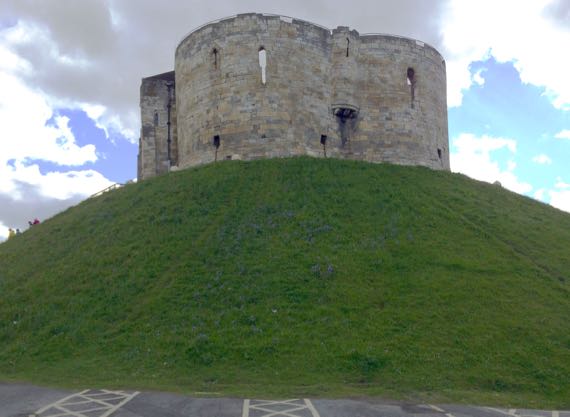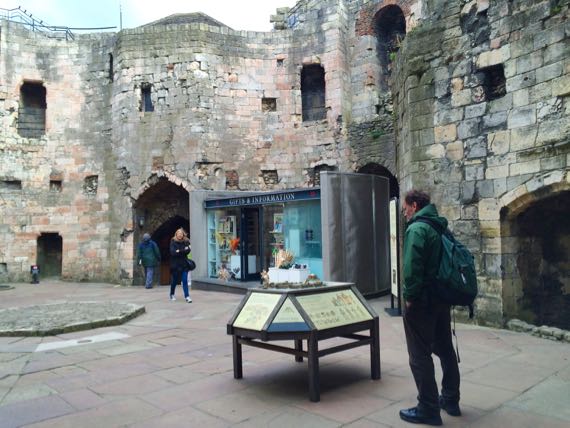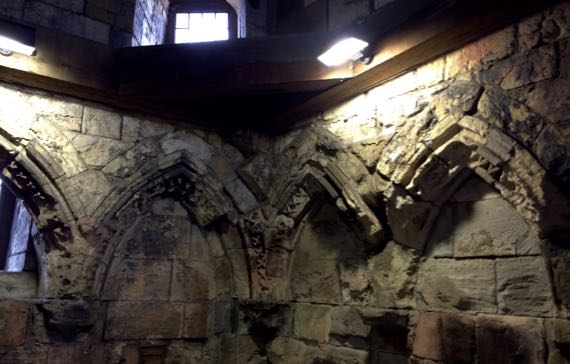
The whole city wall thing seems like it’s from another age. And that is true of this one…it’s the current incarnation of York’s Medieval wall. This view is west, toward Micklegate Bar. Gatehouses are called bars here. And –gate in Micklegate is from the Norse for main as in Main Street. This version of the wall dates to about 15 decades ago, when the parapet wall was added to make strollers feel safer. Notes Simon Mattam for The Friends of York Walls (p12 of the 24.04.2014 version of “On the Walls—A Guide to York’s City Walls Trail”):
The Romans started York around 71 AD. They built walls around their fort and then around the city that grew up on the other side of the River Ouse. Big bits of the walls of the Roman fort can still be seen and up to half of the rest are in the ramparts under the present walls. [Four hundred] years later there were new invasions: Anglian York developed, then Viking York in the 9th century, then Norman York in the 11th century; over this time the Roman walls fell but ramparts grew.
About 900 years ago, the times we call “the Middle Ages” began—these were when the present Walls were built—mainly to protect York against the Scots. Around 500 years ago the Middle Ages ended and cannon were making military walls less useful; in spite of this the Walls were strengthened in the 1640s for the English Civil War. The Walls were seriously attacked and damaged in this war of King against parliament—but luckily a conditional surrender of the city stopped the damage and the parliamentarian victors arranged their speedy repair.
About 200 years ago there was another sort of battle being fought in York—over whether the Walls should be knocked down to open up the city to traffic and fresh air. During Victorian times a compromise developed: small bits of wall were demolished and new arches were built through the Walls but most of the Walls were repaired and opened as a footpath.
Thick stone defensive walls make me think of castles, at least in this part of the world. And there’s one that survives here, not large at all, crowning a human-made, steep-sided hill. It’s called Clifford’s Tower. Actually, this surviving architecture became the keep of York Castle.

The first castle of York dates to the time of William the Conquerer, in 1068. King John of the Magna Carta stayed here…. Later, in the mid-13th-C Henry III had this version built, in a style that resembles French castles of the time. Its quatrefoil plan is very unusual in Britain. The castle was surrounded by a moat that is long gone. Its land connection was via another moated, walled area, that housed many support functions for the keep.

In those days, the interior was roofed over, with two floors. The squarish holes are where the ends of the beams that held the upper floor were seated. Contained in the wall above the entrance gate is a room that’s beneath the small roof that peeks above the wall in this view. When the portcullis was raised, it went into that room.

The other function of that room in those days was as a chapel. The room was repurposed multiple times, but the fancy carvings that framed the old window openings remain, battered and mute.

Okay. Food. I often get requests for food pictures. Brit-food isn’t…or usually isn’t…terribly well regarded. I have many photos of Full English Breakfasts, which is the most British “dish” we normally eat. Both of us are getting tired of tomato-y beans (called Beanz by Heinz in the canned version). Also, fish and chips (had this once, in Hastings) isn’t particularly pretty.
So, instead: dessert! We found this Belgian chocolate cake, lightly heated, with vanilla ice cream from a local creamery, divine. And I spooned away with a view of the sunlit façade of York Minster…really special. We are very lucky.